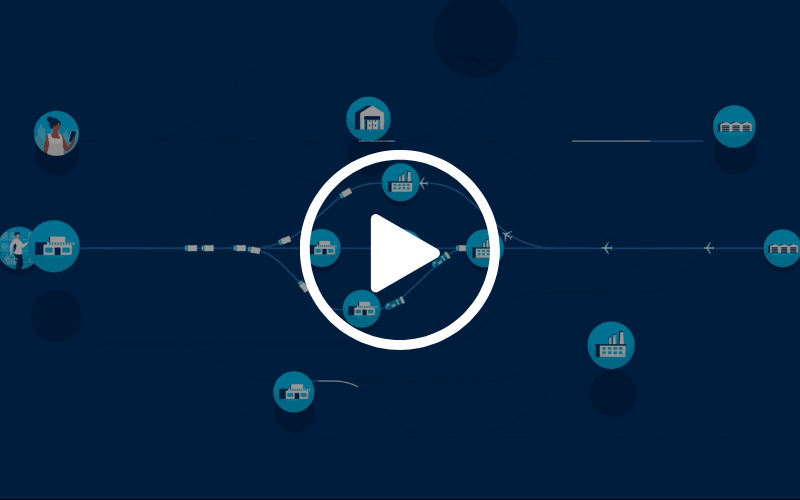Three Core Building Blocks To Create a Resilient Supply Chain
Supply chains were on the verge of recovering from the impact of COVID-19 pandemic when yet again they were plunged into turmoil due to the conflict in Ukraine. From the extremely visible and immediately felt increase in crude oil prices, the conflict is disrupting everything from food (wheat, corn, and sunflower oil exports), automotive (various metals including copper and iron) and semiconductors (90% of neon comes from Russia). This is the latest in a series of supply chain disruptions that have become so common they are now part of pop culture responsible for everything from break ups to missed homework.
As supply chains continue to battle against disruptions and changing market dynamics, the discussion around supply chain resilience has never been more important. Supply Chain resilience defines the ability of a supply chain to weather the impact of a disruption, the ability to bounce back from its negative impact and possibly the ability to take advantage of it.
For decades, supply chain professionals have focused on optimizing the supply chain to reduce costs and increase efficiency with little or no focus on resilience – with the assumption that investments into resilience will be underutilized or the opportunity cost would be too high.However, a recent article from McKinsey estimates that “supply-chain disruptions cost the average organization 45% of one year’s profits over the course of a decade.”
Interestingly, resilient companies significantly outperform their peers during both times of crisis and normal operations. In fact, an extensive BCG quantitative study of nearly 1,800 companies over 25 years shows that supply chains that are resilient outperform their competition by 30% in crisis periods and nearly 16% in stable periods when measured on Total Shareholder Return.
The meaning and manifestation of supply chain resilience can vary greatly depending on the company; however, there are three core building blocks that can enhance supply chain resilience:
- Supply Chain Visibility
- Scenario Planning
- Data Driven Decision Making
1. Supply Chain Visibility
End-to-end supply chain visibility is the ability to track raw materials, finished goods and key assets as they move through your supply chain from suppliers, to manufacturers, to omni-channel retailers, to the end consumer. Simply put you can’t manage what you can’t see and with the current environment not only do supply chains professionals need to see aspects like inventory and orders but also disruptions to predict their impact on the supply chain and be in a position to take mitigating actions.
A supply chain visibility solution must include:
- Ability to ingest and manage enterprise data. For example, inventory status across the supply chain, order information, transit information, labor availability, and throughput constraints.
- Ability to ingest and understand external data. For example, extreme weather, traffic data, major disruptions due to port closure, strikes, and geopolitical unrest.
- Ability to ingest streaming data from IoT devices that measure location and condition.
- KPIs and analytics that describe the health of your supply chain at one glance.
- Artificial intelligence (AI)/machine learning (ML) capabilities to model the disruption, predict impact and be able to prescribe alternatives to mitigate negative impact.
- Ability to push data and insights into upstream and downstream supply chain solutions like Supply Planning, Demand Planning, Warehouse Management System (WMS), Transport Management System and Customer Service.
Enhancing visibility has a direct impact on resilience by giving you the ability to stay ahead of supply chain disruptions and not merely react post facto. Enhancing supply chain visibility and in turn supply chain resilience has a direct impact on customer services, customer experience, revenue, and costs. The earlier you can sense the disruption the more profitable your response can be.
To learn more, hear from Jodi Larson, General Manager, Microsoft Cloud Supply Chain Strategy and Transformation, on how Supply chain visibility is helping Microsoft create a more resilient cloud.
2. Collaborative Scenario Planning
Collaborative scenario planning is the process and the ability to consider evolving market conditions, understand their impact on the supply chain and develop cross-functional plans to best manage both the risk and opportunities created by supply chain disruptions.
The first step is to identify key insights that impact your supply chains. This includes both external factors such as consumer behavior, channel preference shifts, competition, regulations, and the continued impact of climate change, as well as internal factors like corporate strategy, upcoming NPI launches, labor shortages, and capacity constraints.
The next step in the process is to model these insights into a set of coherent assumptions that represent a range of possible scenarios. Then, against each of these scenarios, identify risks and opportunities, develop a response, and evaluate alternatives based on a rigorous cost benefit analysis.
The last step in this process is to develop a holistic action plan. This can be done by assigning probability, calculating a weight scenario outcome, and picking based on probability ranges or by developing plans for the most likely outcome.
Although collaborative scenario planning is a critical disruption management mechanism, companies cannot exhaust planner resources to create an infinite number of scenarios to manage every change or exception. By leveraging a combined deployment of AI/ML, heuristics, and advanced solvers – organizations can improve plan quality by creating optimized plans that reduce the quantity of scenarios that need to be evaluated. This saves time and allows planners to focus on the action plan instead of modeling insights.
To learn more, hear from Harish Lade, Vice President Supply Chain, at Asian Paints on how adaptive planning is helping create new opportunities during the pandemic.
3. Data Driven Decision Making
Supply Chain Resilience is not a one-time project, it is a long-term program of continued, sustained transformation and improvements across multiple facets of the supply chain. The ability to logically anticipate, sense and respond to disruption depending on the industry and market can be as simple as rerouting inventory and expediting shipping or as complex as diversifying strategic suppliers. In many cases the response to disruption is focused on optimizing results as measured by a single KPI like preventing loss of sales, meeting shipping SLAs or reducing costs.
The effectiveness of mitigating actions cannot just focus on a singular reactive KPI but need to be aligned to the central organization strategy. Beyond the reaction, efforts to enhance resilience need to be effective over the long term in addition to being repeatable, adaptable, and sustainable. To achieve this long-term sustained impact, supply chain resilience efforts should function in a framework that helps align tactics to organizational KPIs and a central strategy. These strategic KPIs include:
- Customer Service Levels
- ESG Initiatives
- OTSR Metrics
- Revenue Growth
- Cash to Serve
- Cost to Serve

By measuring the performance of various tactics and decisions against these key metrics ensures that not only the immediate goals are met but also the actions have a sustained positive impact on the supply chain.
The quest for supply chain resilience is not a new one, however, there is a significant uptick in the speed, variety, and impact of supply chain disruptions. Geopolitical risk, strikes, labor shortages and the continued rising risk of climate change will only add to the complexities of managing a global supply chain. Even beyond managing disruptions, resilient supply chains outperform competition during normal times and can serve as a significant competitive advantage. The false tradeoff between a resilient and agile supply chain versus a cost optimized supply chain is no longer a viable strategy.

